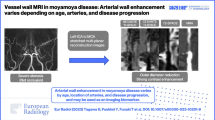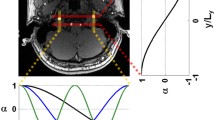Abstract
Background
To obtain information on affected vessels in moyamoya disease (MMD), we analyzed the vascular morphological characteristics of MMD using three-dimensional (3D) constructive interference in steady-state (CISS) magnetic resonance imaging (MRI).
Methods
The population of this 3D-CISS MRI study consisted of 51 patients with MMD: 16 patients with atherosclerotic middle cerebral artery (MCA) stenosis or occlusion, 42 MRI control patients, and 28 control digital subtraction angiography (DSA) patients. We measured the outer diameters of the terminal portion of the internal carotid artery (ICA) and the proximal portion of the MCA (M1 portion). We evaluated the inner diameter as the relative value (%) obtained from magnified DSA images and analyzed these data.
Results
The outer diameters of the ICA and M1 portions were significantly smaller in the MMD group than in the other two groups, while the M1 outer diameter of the atherosclerosis group was not significantly different compared to the control (ICA: MMD, 2.61 ± 0.46 mm vs. control, 4.04 ± 0.50 mm and M1: MMD, 1.92 ± 0.43 mm vs. control, 3.34 ± 0.54 mm vs. atherosclerosis, 3.45 ± 0.56 mm). Furthermore, in MMD patients, the outer diameter was unrelated to the progression of the luminal stenosis grade estimated by DSA.
Conclusions
This is the first report that the outer diameters of both the ICA and M1 decrease in MMD patients. Our findings suggest that the vascular constrictive changes of the affected arteries are an important phenomenon reflecting MMD pathology.




Similar content being viewed by others
References
Suzuki J, Takaku A, Cerebrovascular “moyamoya” disease (1969) Disease showing abnormal net-like vessels in base of brain. Arch Neurol 20:288–299
Fukui M (1997) Guidelines for the diagnosis and treatment of spontaneous occlusion of the circle of Willis ('moyamoya' disease). Research Committee on Spontaneous Occlusion of the Circle of Willis (Moyamoya Disease) of the Ministry of Health and Welfare, Japan. Clin Neurol Neurosurg 99(Suppl 2):S238–S240
Hasuo K, Mihara F, Matsushima T (1998) MRI and MR angiography in moyamoya disease. J Magn Reson Imaging 8:762–766
Yamada I, Suzuki S, Matsushima Y (1995) Moyamoya disease: comparison of assessment with MR angiography and MR imaging versus conventional angiography. Radiology 196:211–218
Casselman JW, Kuhweide R, Deimling M, Ampe W, Dehaene I, Meeus L (1993) Constructive interference in steady state-3DFT MR imaging of the inner ear and cerebellopontine angle. AJNR Am J Neuroradiol 14:47–57
Houkin K, Aoki T, Takahashi A, Abe H (1994) Diagnosis of moyamoya disease with magnetic resonance angiography. Stroke 25:2159–2164
Harada A, Fujii Y, Yoneoka Y, Takeuchi S, Tanaka R, Nakada T (2001) High-field magnetic resonance imaging in patients with moyamoya disease. J Neurosurg 94:233–237
Hirai T, Kai Y, Morioka M, Yano S, Kitajima M, Fukuoka H, Sasao A, Murakami R, Nakayama Y, Awai K, Toya R, Akter M, Korogi Y, Kuratsu J, Yamashita Y (2008) Differentiation between paraclinoid and cavernous sinus aneurysms with contrast-enhanced 3D constructive interference in steady- state MR imaging. AJNR Am J Neuroradiol 29:130–133
Yang D, Korogi Y, Ushio Y, Takahashi (2000) Increased conspicuity of intraventricular lesions revealed by three-dimensional constructive interference in steady state sequences. AJNR Am J Neuroradiol 21:1070–1072
Yousry I, Camelio S, Wiesmann M, Schmid UD, Moriggl B, Bruckmann H, Yousry TA (1999) Detailed magnetic resonance imaging anatomy of the cisternal segment of the abducent nerve: Dorello's canal and neurovascular relationships and landmarks. J Neurosurg 91:276–283
Komiyama M, Ishiguro T, Nishikawa M, Yasui T, Morikawa T, Kitano S, Sakamoto H (2002) Constructive interference in steady state imaging of moyamoya disease. Neurol Med Chir (Tokyo) 42:11–16
Kinoshita Y, Kohshi K, Yokota A (1998) Moyamoya disease of adult onset brain stem haemorrhage associated with bilateral occlusion of the vertebral arteries–case report. Acta Neurochir (Wien) 140:181–184
Miyamoto S, Kikuchi H, Karasawa J, Nagata I, Ikota T (1984) Moyamoya disease associated with bilateral occlusion of the vertebral artery. Surg Neurol 22:21–28
Kuroda S, Houkin K (2008) Moyamoya disease: Current concepts and future perspectives. Lancet Neurol 7:1056–1066
Yang SH, Li B, Wang CC, Zhao JZ (1997) Angiographic study of moyamoya disease and histological study in the external carotid artery system. Clin Neurol Neurosurg 99(Suppl 2):S61–S63
Yasaka M, Ogata T, Yasumori K, Inoue T, Okada Y (2006) Bottle neck sign of the proximal portion of the internal carotid artery in moyamoya disease. J Ultrasound Med 25:1547–1552
Glagov S, Weisenberg E, Zarins CK, Stankunavicius R, Kolettis GJ (1987) Compensatory enlargement of human atherosclerotic coronary arteries. N Engl J Med 316:1371–1375
Fukui M, Kono S, Sueishi K, Ikezaki K (2000) Moyamoya disease. Neuropathology 20(Suppl):S61–S64
Hosoda Y, Ikeda E, Hirose S (1997) Histopathological studies on spontaneous occlusion of the circle of Willis (cerebrovascular moyamoya disease). Clin Neurol Neurosurg 99(Suppl 2):S203–S208
Takekawa Y, Umezawa T, Ueno Y, Sawada T, Kobayashi M (2004) Pathological and immunohistochemical findings of an autopsy case of adult moyamoya disease. Neuropathology 24:236–242
Ikeda E, Maruyama I, Hosoda Y (1993) Expression of thrombomodulin in patients with spontaneous occlusion of the circle of Willis. Stroke 24:657–660
Schoenhagen P, Ziada KM, Kapadia SR, Kapadia SR, Crowe TD, Nissen SE, Tuzcu EM (2000) Extent and direction of arterial remodeling in stable versus unstable coronary syndromes: an intravascular ultrasound study. Circulation 15 101(6):598–603
Varnava AM, Mills PG, Davies MJ (2002) Relationship between coronary artery remodeling and plaque vulnerability. Circulation 105(8):939–943
Li ML, Xu WH, Song L, Feng F, You H, Ni J, Gao S, Cui LY, Jin ZY (2009) Atherosclerosis of middle cerebral artery: evaluation with high-resolution MR imaging at 3 T. Atherosclerosis 204(2):447–452
Im SH, Oh CW, Kwon OK, Kim JE, Han DH (2005) Moyamoya disease associated with Graves disease: special considerations regarding clinical significance and management. J Neurosurg 102:1013–1017
Tendler BE, Shoukri K, Malchoff C, MacGillivray D, Duckrow R, Talmadge T, Ramsby GR (1997) Concurrence of Graves' disease and dysplastic cerebral blood vessels of the moyamoya variety. Thyroid 7:625–629
Inaba M, Henmi Y, Kumeda Y, Ueda M, Nagata M, Emoto M, Ishikawa T, Ishimura E, Nishizawa Y (2002) Increased stiffness in common carotid artery in hyperthyroid Graves' disease patients. Biomed Pharmacother 56:241–246
Nakamura K, Yanaka K, Ihara S, Nose T (2003) Multiple intracranial arterial stenoses around the circle of Willis in association with Graves’ disease: report of two cases. Neurosurgery 53:1210–1214, discussion 1214-5
Panegyres PK, Morris JG, O'Neill PJ, Balleine R (1993) Moyamoya-like disease with inflammation. Eur Neurol 33:260–263
Conflicts of interest
None.
Grant support
This work was supported by Grants-in-Aid for Scientific Research from the Ministry of Education, Sports, Science and Culture of Japan.
Author information
Authors and Affiliations
Corresponding author
Additional information
Yasuyuki Kaku and Motohiro Morioka contributed equally to this work.
Rights and permissions
About this article
Cite this article
Kaku, Y., Morioka, M., Ohmori, Y. et al. Outer-diameter narrowing of the internal carotid and middle cerebral arteries in moyamoya disease detected on 3D constructive interference in steady-state MR image: is arterial constrictive remodeling a major pathogenesis?. Acta Neurochir 154, 2151–2157 (2012). https://doi.org/10.1007/s00701-012-1472-4
Received:
Accepted:
Published:
Issue Date:
DOI: https://doi.org/10.1007/s00701-012-1472-4




